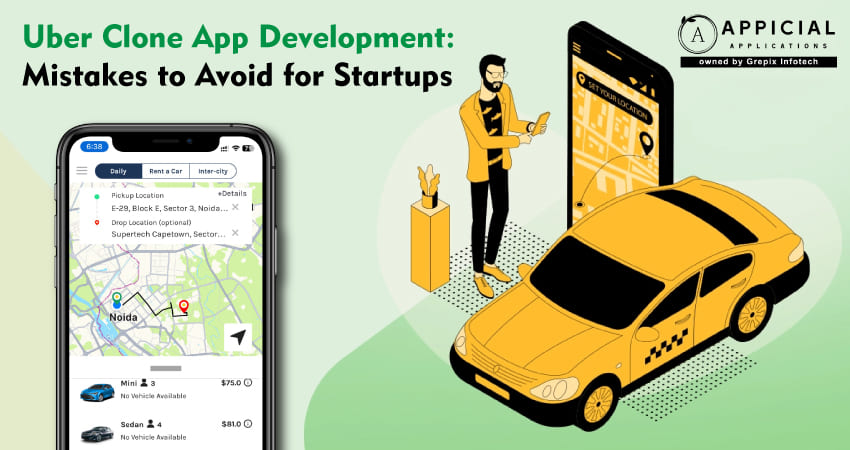
Uber Clone App Development: Mistakes to Avoid for Startups
Embarking on the journey of developing an Uber clone app is a thrilling venture for many startups. As we delve into the digital era, the demand for convenient, on-demand transportation services continues to escalate, offering vast opportunities for emerging businesses. However, the path to creating a successful app is fraught with potential pitfalls. It’s essential to learn from the mistakes others might have made along the way to ensure your venture thrives in this competitive landscape. This blog aims to guide you through some common mistakes to avoid in Uber clone app development, paving the way for a smooth and successful startup journey.
Developing an Uber clone app presents significant opportunities for startups but requires careful planning to avoid common pitfalls. Key mistakes to avoid include insufficient market research, ignoring user feedback, and inadequate security measures. Enhancing user experience is crucial, focusing on a user-friendly interface, seamless navigation, and personalized features. The technical performance of the app, including efficient backend development and utilizing cloud services, is essential for handling high loads. Monetization strategies like subscription models, in-app advertising, and partnerships can drive revenue. By addressing these areas, startups can increase their chances of success in the competitive mobile app market.
Common Mistakes in Uber Clone App Development
Lack of Market Research
One critical pitfall that many startups encounter during the initial stages of Uber clone app development is the lack of comprehensive market research. The excitement of launching a new app can often overshadow the necessity for thorough understanding of the targeted market. This includes demographics, consumer behavior, existing competition, and current market demands. Failing to conduct detailed market research can lead to misjudging the app’s feature requirements, pricing strategies, and promotional activities.
Furthermore, market research not only aids in tailoring the app’s features to meet consumer needs but also assists in identifying unique selling points (USPs) that can differentiate your app in a saturated market. It’s essential to have a clear comprehension of what potential users want, what your competitors are offering, and how your app can offer something superior or different.
Ignoring User Feedback
A common oversight for many startups is ignoring user feedback during and after the development process. Engaging with early users and soliciting their feedback is invaluable as it provides real insights into what actually works and what doesn’t. This feedback is crucial for iterative development, helping to refine the app and enhance user satisfaction. Failing to incorporate user feedback can result in an app that does not fully resonate with its intended audience, which may lead to lower adoption rates.
In practice, implementing mechanisms to gather continuous user feedback, such as in-app surveys, user testing sessions, and feedback forms can significantly enhance the quality and effectiveness of the app. Regular updates based on user feedback also demonstrate a commitment to user satisfaction, fostering a positive relationship with the user base.
Inadequate Security Measures
In the digital age, security is non-negotiable. When developing an Uber clone app, inadequate security measures can lead to severe consequences, including data breaches, unauthorized access, and loss of user trust. It is essential to integrate robust security protocols right from the start of app development.
This includes implementing measures like secure socket layers (SSL), data encryption, secure authentication mechanisms, and regular security audits. A breach, apart from resulting in legal repercussions, can permanently tarnish the app’s reputation. Ensuring that personal and financial information of users is protected not only complies with data protection laws but also builds trust and reliability in the eyes of the users.
Enhanced Customer Engagement
Today's businesses strive to engage customers more deeply and meaningfully. By utilizing interactive platforms and responsive service models, companies can create personalized experiences that resonate with individual preferences and needs. This approach fosters a stronger connection between the brand and its customers, encouraging ongoing interaction and loyalty.
Importance of User Experience in Uber Clone App Development
User experience (UX) plays a fundamental role in the success of any app. In the context of an Uber clone app, excellent UX can significantly differentiate your app from competitors. This section explores critical elements that enhance user experience.
User-Friendly Interface
The interface of your Uber clone app is often the first point of interaction between the user and your service. A user-friendly interface is crucial for ensuring that users find the app accessible and easy to use. An overly complicated or cluttered interface can deter users, leading to poor retention rates.
To design an interface that appeals to users, it is important to focus on simplicity and clarity. Use intuitive designs that are easy to navigate. Elements like buttons, icons, and texts should be clearly visible and self-explanatory. Incorporating elements like quick tutorials or help sections can further aid in enhancing the user-friendliness of the app. Remember, the goal is to make the ride-booking process as seamless and straightforward as possible.
Seamless Navigation
Seamless navigation is critical for an app that demands real-time capabilities like an Uber clone. Users should be able to move through the app effortlessly to perform actions such as booking a ride, checking ride history, or updating their profiles. Poor navigation can lead to frustrations that might prompt users to abandon the app in favor of a competitor.
To ensure seamless navigation, logically organize the content and ensure that the app’s layout is consistent across different pages. Test the navigation flow thoroughly during the development phase and make adjustments based on user feedback to ensure that users can find what they need with minimal effort.Personalized Features for Users
Personalization can significantly enhance user experience by making users feel recognized and valued. In an Uber clone app, personalization options could include saving favorite destinations, customized ride suggestions based on user history, preference settings for vehicle types, and even personalized discounts or promotions.
Implementing these features requires a comprehensive understanding of user data and behavior, which can be gathered through advanced analytics and user feedback. By providing personalized experiences, you can increase user engagement and loyalty, which are critical factors for the long-term success of the app.
In conclusion, avoiding common development mistakes and focusing on creating a superior user experience are both crucial elements in developing a successful Uber clone app. By understanding and addressing these areas, startups can greatly enhance their chances of succeeding in the competitive app market.
Optimizing Performance and Speed in Uber Clone App Development
Developing an Uber clone app that is swift and efficient requires attention to several technical details. It's essential for startups to imbue their applications with the capacity to handle high loads and operate smoothly across diverse platforms and devices. Performance and speed are not just features but the backbone of user retention and app usability in competitive markets.
Efficient Backend Development
The backend of your Uber clone app is where the magic happens. It's crucial to ensure that the server, application, and database communicate efficiently with each since any latency in this communication can lead to slower response times and a poor user experience. Utilizing streamlined algorithms and maintaining an organized database structure can significantly reduce processing times and enhance app responsiveness. Moreover, adopting microservices architecture can allow different components of your app to operate independently, which minimizes the risk of system failures and accelerates developmental processes. This architecture also enables easy updates and scalability without disrupting the entire system.
Utilizing Cloud Services
Cloud services offer scalable solutions that are perfect for handling the variability in demand, typical of Uber-like applications. By leveraging cloud platforms, startups can enjoy flexible server usage that scales as the user base grows, thus optimizing operational costs and improving performance. Cloud providers like Amazon AWS, Microsoft Azure, and Google Cloud offer robust infrastructure that ensures data redundancy, high availability, and enhanced security. Additionally, these platforms provide analytics tools that help in monitoring, managing, and optimizing app performance in real-time, thus maintaining a seamless user experience even during peak traffic times.
Regular Testing and Debugging
Continuous testing and debugging play an essential role in maintaining the performance and speed of your Uber clone app. Implementing automated testing strategies such as unit testing, integration testing, and performance testing helps in identifying and fixing bugs before they affect your users. Performance testing, in particular, is crucial as it simulates different usage scenarios to ensure that the app remains responsive under various stress conditions. Moreover, regular debugging and code reviews help in refining the code and enhancing efficiency. It is a good practice to set up a dedicated QA team to oversee the testing cycles, ensuring that any potential issues are resolved promptly and do not compromise the user experience.
Also Read: Why You Should Choose White Label Taxi App For Your Taxi Business
Monetization Strategies for Uber Clone Apps
Creating a successful business model for an Uber clone app involves more than just performing smooth operations; it necessitates implementing effective monetization strategies. These not only help in recovering the investment but also in generating a steady flow of revenue. Startups need to explore a variety of monetization models to figure out which one aligns best with their business goals and market demands.
Subscription Models
One effective monetization approach is the subscription model. In this framework, users are charged a regular fee monthly or yearly to enjoy enhanced features or premium services. For instance, offering a monthly subscription that eliminates surge pricing could be particularly appealing during peak hours. Similarly, a tiered subscription model could be introduced where different levels provide varying degrees of accessibility and perks. This model encourages user retention and provides a predictable revenue stream, which is extremely useful for financial planning and business stability.
In-App Advertising
In-app advertising is another viable strategy for monetizing your Uber clone app. By integrating ads into the app, you can generate revenue from businesses looking to reach your user base. However, it’s crucial to ensure that the advertisements are relevant and non-intrusive, as excessive or irrelevant ads can detract from the user experience and potentially drive users away. Carefully selecting advertisers that align with your audience’s preferences and behaviors can enhance the effectiveness of the ads and increase click-through rates.
Partnerships and Collaborations
Establishing partnerships and collaborations can open up additional revenue streams for your Uber clone app. For example, collaborating with local businesses or events can provide exclusive services to your users, such as on-demand rides to concerts or sports events, which can enhance their overall experience. Furthermore, such partnerships can include promotional efforts where businesses subsidize a portion of the cost for rides to their locations or events, creating a win-win situation for all parties involved. Strategic collaborations can also extend to service integrations, like offering hotel or restaurant bookings through your app, which not only improves user engagement but also diversifies your income sources.
By meticulously integrating these monetization strategies, startups can ensure not only the sustainability of their Uber clone app but also its profitability and long-term success. Crafting a balance between a great user experience and effective revenue generation is key to standing out in the competitive landscape of mobile apps.Conclusion
In the journey of developing an Uber clone app, recognizing and circumventing common missteps can significantly influence the success of your startup. By carefully planning your strategy, focusing on user-centric design, meticulously testing the app, and preparing for scalability, you lay down a strong foundation that supports sustainable growth and user satisfaction. Keep these guidelines in mind to ensure your venture not only launches successfully but also thrives in the competitive rideshare market. Always aim for innovation and user satisfaction, and you'll set your app apart from the rest.
Launch your vision with our mobile app development company, where innovation meets excellence to create cutting-edge mobile solutions.





